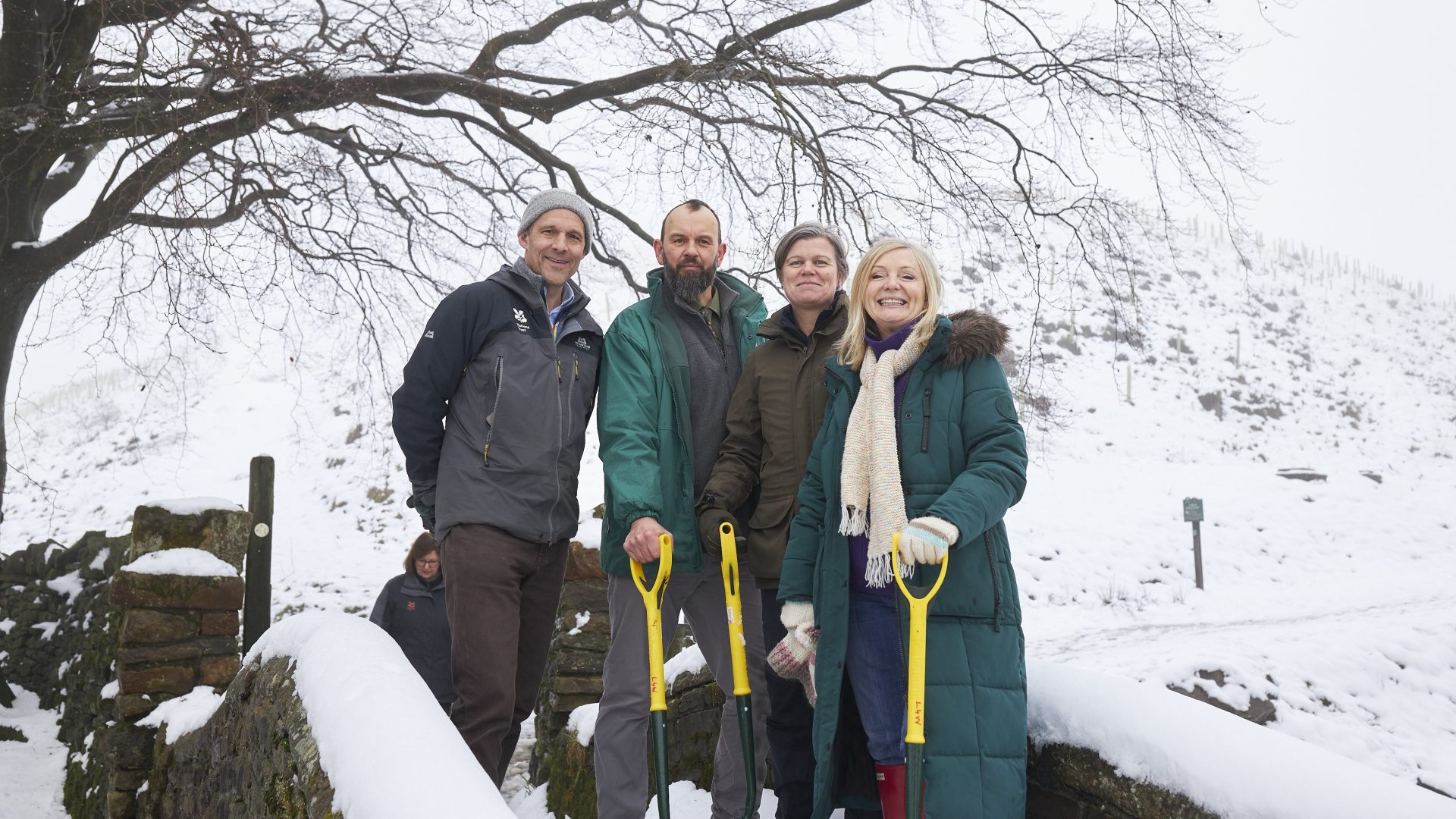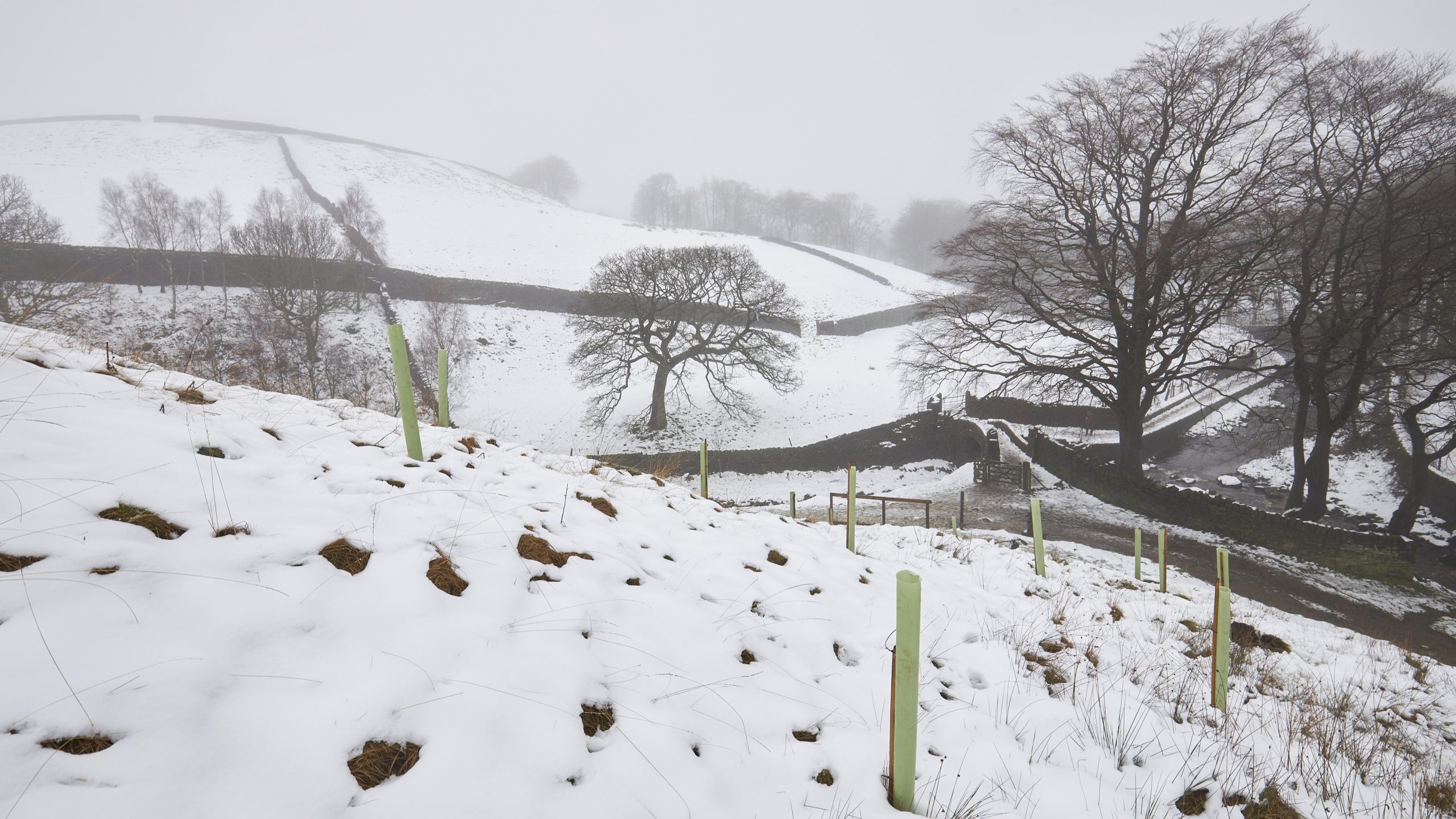Had you been walking your dog on Marsden Moor, West Yorkshire, one snowy Friday morning in February this year, you would have been treated to an unusual sight. The mayor of West Yorkshire, the CEO of Yorkshire Water, the National Trust’s Regional Director for the North, and leading members of various environmental organisations were perched on the side of a steep hill, digging holes in the snow-covered ground, and dropping in what looked like twigs.
The sight was incongruous, but the vision is ambitious. These ‘twigs’ (actually two-year-old saplings, known as whips) are some of the first physical signs of a conservation programme that is set to transform the landscape of the South Pennine region. Around 300,000 of these baby trees will eventually form new native woodlands that will help to turn the environmental clock back, and help stop the region’s flooding problem at the same time.

“Landscapes for Water is a project between us and the National Trust, with support from several additional partners,” explains Nicola Shaw, Yorkshire Water’s CEO. “We have been working together to identify landscape scale interventions that can protect the local environment and local people from climate-emergency associated risks, such as floods. Planting 300,000 trees is just one of several schemes we’re embarking on.”
The programme isn’t the first time that Yorkshire Water have partnered with the National Trust on joint climate-impact mitigation. As Yorkshire’s two biggest landowners, they first made an agreement to work together – known as the ‘Common Cause’ – in 2019. The following year, with additional support from the Woodland Trust, they planted 112,000 trees, installed 435 natural flood management leaky dams, and undertook peatland restoration at Gorpley Reservoir, Todmorden.
Landscapes for Water was inspired by the success of these past programmes. “We know that we have to be ambitious given the scale of the potential risks of the climate-emergency, and we also know that when working with our partners, we can see brilliant results,” explains Nicola. “This nature-led campaign will cover 5,500 hectares of land, across both our land and the Trust’s.”
In addition to 300,000 trees, it will include the installation of 3,500 natural flood management leaky dams and the implementation of peatland restoration techniques such as planting sphagnum mosses. “The combined result of these schemes will go a long way towards ensuring residents are safe from flooding – as well as enabling us to continue to deliver safe, quality clean drinking water to local homes and businesses.”
Such natural interventions are now thought to be vital in turning the clock back on the degradation of the landscape, which – as weather events become more extreme – has led to issues with fire and flooding around the South Pennines.
In the Mesolithic period, going back to c8000-4000BC, there would have been much more woodland and scrub in this upland landscape, particularly on the moorland fringes. Meanwhile, on the damp environment of the moorland tops, peat began forming 6,000 years ago, accumulating up to 6m deep in places. This resulted in a boggy haven for wildlife, carbon staying locked away, and water remaining on the moors.
In the centuries since, much of the woodland has been felled for building or charcoal. The peatlands have been marred by industrial emissions and drained to make the ground suitable for grouse or grazing.
Today West Yorkshire regularly makes the headlines for flooding through the winter months, as increasingly frequent ‘named storms’ batter the moorlands and cascades of rainwater surge down into valley towns. By planting more trees and slowing the flow of water off the moor, the Landscapes for Water programme will prevent flooding of these downstream communities.
However, making these kinds of changes in the UK can be a lengthy process. Unlike elsewhere in Europe, there is an immense amount of red tape and legislation around nature restoration activities such as designing and planting woodland. Multiple surveys, assessments and consultation with statutory and non-statutory stakeholders are required to inform the designs. Lengthy and complex Regulatory processes, including Environmental Impact Assessment (EIA), Habitat Regulations Assessment (HRA), and SSSI Consent, are likely needed.
The National Trust and Yorkshire Water have joined forces with additional partners, who can help to overcome any hurdles that the various assessments and consultations may bring. Landscapes for Water is breaking new ground as a joined-up conservation programme, and support from the Environment Agency, Natural England and the Woodland Trust has been invaluable.
“By linking up with our various partners, we’ve been able to call on expert support whenever we have needed it – ensuring we’re always taking the right steps and doing the right thing,” Nicola adds.
Landscapes for Water’s trees will also form part of the White Rose Forest – Yorkshire’s community forest – and were funded by an additional £1 million via the Trees for Climate programme, part of the Government’s Nature for Climate Fund. The partnership also received £1.9 million from the West Yorkshire Combined Authority to fund these schemes – hence Mayor Tracy Brabin’s presence at the tree-planting ceremony in February. “This support from the West Yorkshire Combined Authority is strongly welcomed by the project and we are hopeful that the partnership will continue,” says Nicola.
Now the first phase of Landscapes for Water has begun in Marsden, with 65,000 new trees already planted, and the installation of around 1,000 leaky dams that will begin in the autumn. The next part of the programme will move onto Yorkshire Water land, around four major reservoirs stretching from the Colne Valley in the south to Heptonstall in the Calder Valley in the north.
Once these new trees have grown into mature clough woodlands of oak, rowan, birch and holly, the partners believe there will be more flood water staying on the moor, and far less affecting downstream communities.
Shaw is confident that partnerships like these can do more than the organisations can alone to mitigate the impact of climate change, and – by harnessing the power of nature – can prepare the land for an uncertain future. “Together we can achieve a better outcome for the area,” she says. “If we take the right path, between us, we will be successful.”
Natural flood management fact file:
- In England alone, more than one in six properties (around 5 million) are at risk of flooding.
- Nature-based solutions to issues of flooding have entered the mainstream in the past few years, after a number of small-scale studies showed their effectiveness. More landscape-scale projects, like Landscapes for Water, are now underway.
- As well as providing sustainable flood risk management and climate change adaptation, Natural Flood Management has been shown to increase biodiversity and improve water quality as well as improve mental health.
- Research last year showed that forests and woodland were worth £843 million and £420 million to the country’s flood defences respectively.
- This is partly because tree canopies catch around 30% of rainfall, so it evaporates back into the atmosphere directly without ever reaching the ground – and partly because root systems under trees help water penetrate deeper into the soil at a faster rate.
- Trees and hedges are also effective in slowing run-off from farmland, boosting infiltration by 60%. By slowing the flow, they prevent soil and peat erosion and boost water quality (by up to 80%) too.
- Leaky dams, another method of Natural Flood Management, have been shown to reduce the damaging impact of flood waters by around 10%, when used in an upland area of catchment.




